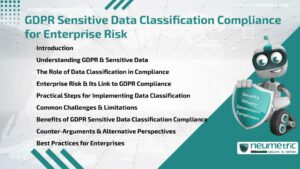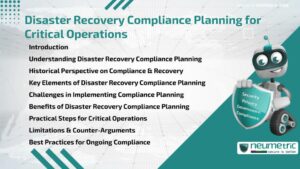Table of Contents
ToggleIntroduction
Disaster Recovery Compliance Planning is the process of aligning recovery strategies for critical operations with Regulatory Standards & Industry guidelines. It ensures that Organisations can resume essential functions swiftly after disruptions while meeting legal & compliance obligations. This practice helps reduce operational Risks, safeguard Data & protect Business Continuity. With increasing regulatory scrutiny & growing Risks from Cyberattacks, Natural Disasters & System Failures, Disaster Recovery Compliance Planning is essential for any Organisation.
Understanding Disaster Recovery Compliance Planning
Disaster Recovery Compliance Planning involves integrating recovery strategies with laws, regulations & standards such as ISO 22301, SOC 2 & HIPAA. While Disaster Recovery focuses on resuming operations, compliance ensures that recovery aligns with mandatory requirements. For instance, Healthcare providers must adhere to HIPAA rules, while Financial institutions must meet guidelines from the Federal Financial Institutions Examination Council [FFIEC]. This dual approach balances resilience with accountability.
Historical Perspective on Compliance & Recovery
The concept of Disaster Recovery gained prominence in the 1970s when Organisations began depending heavily on computer systems. Compliance Requirements emerged later, as industries realized that downtime & data loss could cause regulatory violations. Over time, frameworks such as the Sarbanes-Oxley Act [SOX] and the General Data Protection Regulation [GDPR] added stricter recovery & compliance mandates. Today, both elements are inseparable, making Disaster Recovery Compliance Planning a cornerstone of organizational resilience.
Key Elements of Disaster Recovery Compliance Planning
Effective Disaster Recovery Compliance Planning includes several essential components:
- Risk Assessment: Identifying Threats such as cyberattacks, natural disasters or internal failures.
- Business Impact Analysis: Determining how disruptions affect critical operations.
- Regulatory Mapping: Aligning recovery processes with applicable laws & standards.
- Recovery Strategies: Establishing backup systems, redundant sites & cloud-based recovery.
- Testing & Audits: Regular drills & compliance reviews ensure readiness.
- Documentation: Maintaining detailed records for regulators & auditors.
Challenges in Implementing Compliance Planning
Organisations often face challenges such as high implementation costs, limited awareness of regulatory updates & resource constraints. Smaller businesses may lack expertise, while larger Organisations may struggle with coordinating across departments. Another common challenge is balancing speed of recovery with strict compliance demands. For example, restoring services quickly may conflict with secure data handling requirements.
Benefits of Disaster Recovery Compliance Planning
The advantages of Disaster Recovery Compliance Planning include:
- Reduced Legal & Financial Risk: Compliance lowers the chance of fines & penalties.
- Enhanced Reputation: Customers & partners trust compliant Organisations more.
- Operational Resilience: Structured recovery minimizes downtime.
- Audit Readiness: Well-prepared documentation eases regulatory inspections.
- Improved Security: Planning strengthens defenses against cyberattacks & insider Threats.
Practical Steps for Critical Operations
Organisations can take practical steps to implement Disaster Recovery Compliance Planning for critical operations:
- Map business processes to regulatory requirements.
- Establish clear recovery time objectives [RTO] and recovery point objectives [RPO].
- Use encrypted backups & secure offsite storage.
- Train Employees regularly on compliance & recovery protocols.
- Conduct Third Party audits for unbiased evaluations.
Limitations & Counter-Arguments
Some critics argue that Disaster Recovery Compliance Planning may create unnecessary bureaucracy, slowing down response times. Others point out that compliance does not guarantee resilience, as real-world disasters can exceed planned scenarios. Additionally, overemphasis on compliance may divert resources from innovation or operational growth. Despite these concerns, most experts agree that compliance planning remains vital for critical operations.
Best Practices for Ongoing Compliance
To maintain effective Disaster Recovery Compliance Planning, Organisations should:
- Update recovery & compliance plans annually.
- Monitor regulatory changes continuously.
- Automate compliance tracking with specialized tools.
- Collaborate with regulators & industry peers.
- Encourage a culture of accountability & readiness across the Organisation.
Takeaways
Disaster Recovery Compliance Planning strengthens both resilience & accountability for critical operations. By aligning recovery strategies with regulatory requirements, Organisations not only reduce Risk but also gain trust & stability. Though challenges exist, the benefits outweigh limitations, making compliance planning a vital part of modern Business Continuity.
FAQ
What is Disaster Recovery Compliance Planning?
It is the process of ensuring Disaster Recovery strategies for critical operations comply with legal & Industry Standards.
Why is Disaster Recovery Compliance Planning important?
It reduces Risks, ensures continuity, prevents regulatory violations & safeguards reputation.
What industries require Disaster Recovery Compliance Planning?
Industries such as Healthcare, Finance, Telecommunications & Government agencies require strict compliance planning.
How often should compliance plans be tested?
Compliance & recovery plans should be tested at least once a year, with more frequent tests for high-Risk industries.
What role do audits play in Disaster Recovery Compliance Planning?
Audits verify that recovery strategies meet regulatory requirements & provide assurance to Stakeholders.
Can Small Businesses benefit from compliance planning?
Yes, Small Businesses can protect themselves from Risks & build trust with clients by implementing scaled compliance plans.
What are common mistakes in compliance planning?
Common mistakes include neglecting updates, ignoring new regulations & failing to train staff properly.
References
- FFIEC IT Examination Handbook
- HIPAA Compliance Guidelines
- General Data Protection Regulation Overview
Need help for Security, Privacy, Governance & VAPT?
Neumetric provides organisations the necessary help to achieve their Cybersecurity, Compliance, Governance, Privacy, Certifications & Pentesting needs.
Organisations & Businesses, specifically those which provide SaaS & AI Solutions in the Fintech, BFSI & other regulated sectors, usually need a Cybersecurity Partner for meeting & maintaining the ongoing Security & Privacy needs & requirements of their Enterprise Clients & Privacy conscious Customers.
SOC 2, ISO 27001, ISO 42001, NIST, HIPAA, HECVAT, EU GDPR are some of the Frameworks that are served by Fusion – a SaaS, multimodular, multitenant, centralised, automated, Cybersecurity & Compliance Management system.
Neumetric also provides Expert Services for technical security which covers VAPT for Web Applications, APIs, iOS & Android Mobile Apps, Security Testing for AWS & other Cloud Environments & Cloud Infrastructure & other similar scopes.
Reach out to us by Email or filling out the Contact Form…





